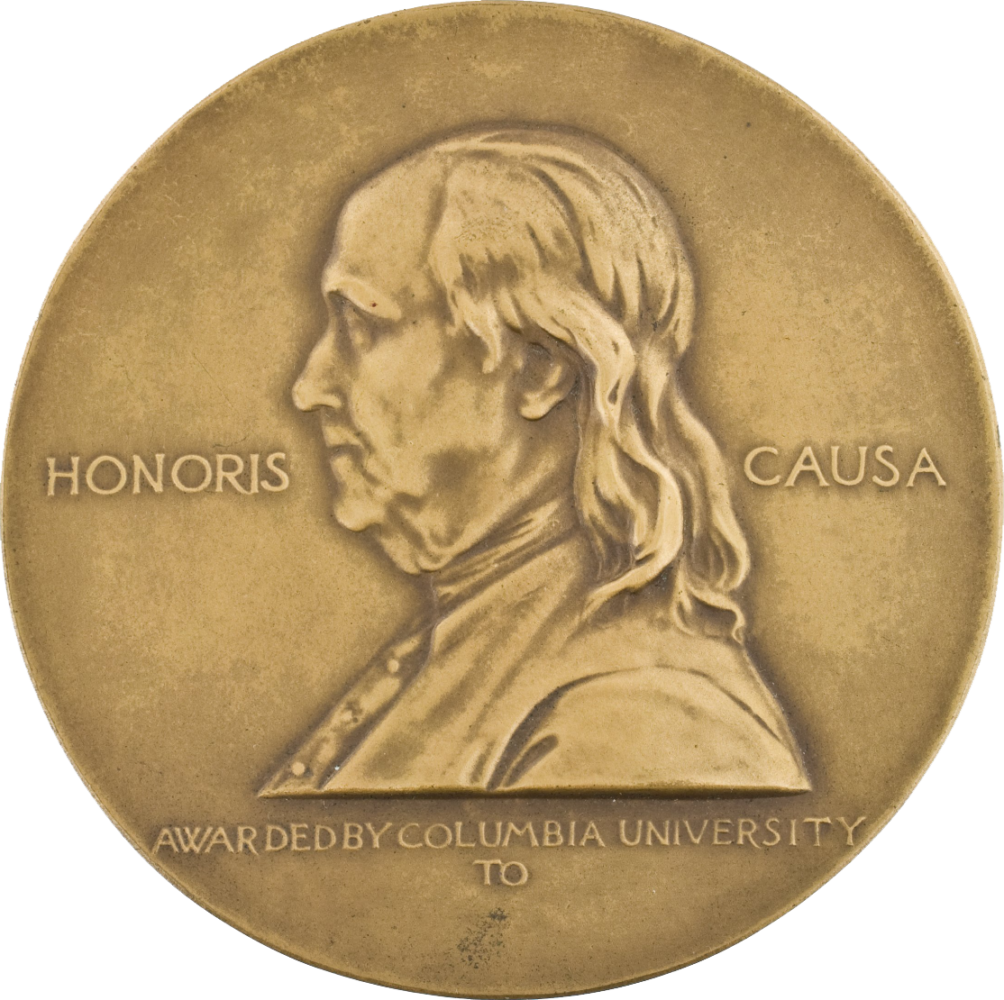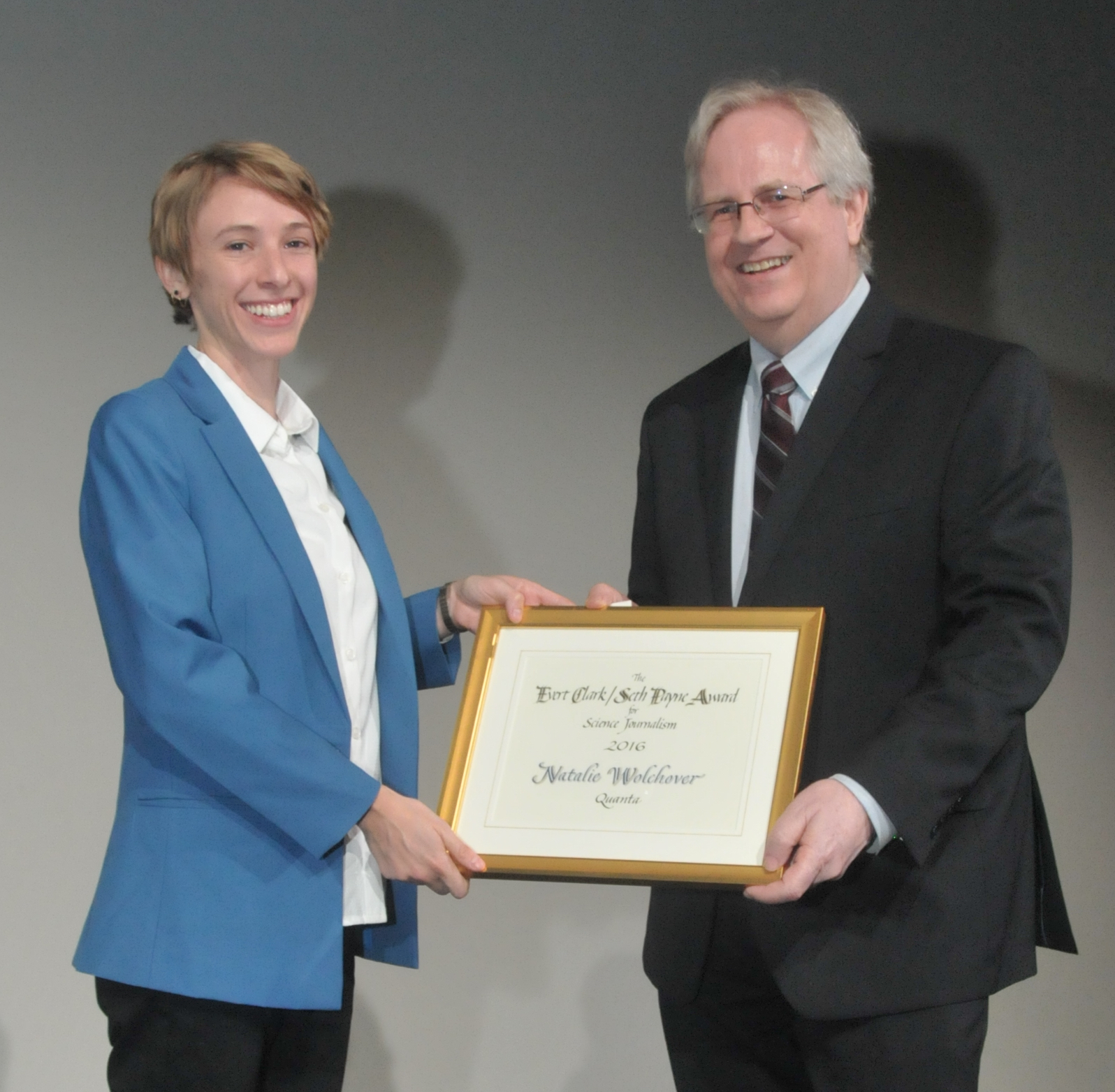
Pulitzers honor CASW awardee’s work, other science journalism
The Pulitzer medal (public domain image via Wikimedia Commons)
The decade-old online science and math magazine Quanta went up against the juggernauts of print journalism to win the prestigious 2022 Pulitzer Prize for Explanatory Reporting. The award cited Natalie Wolchover, Quanta’s senior editor covering the physical sciences and the 2016 winner of CASW’s Clark/Payne Award, for “coverage that revealed the complexities of building the James Webb Space Telescope, designed to facilitate groundbreaking astronomical and cosmological research.”
“We feel deeply honored and thrilled, particularly for this recognition of our wonderfully talented and hard-working colleague @nattyover, who has been a big part of Quanta since the beginning,” @QuantaMagazine tweeted after the announcement.
Based in New York City, Quanta Magazine is one of a new generation of prize-winning non-profit publications. It is an editorially independent magazine specializing in basic science, math and physical sciences as well as biology and computer science with financial support from the Simons Foundation. Quanta has several global syndication partners, with some stories translated into German, Spanish, French, Chinese, Italian and Japanese. This gives the magazine a broad audience far beyond the online publication itself.
Wolchover, 35, was home with a bad case of COVID-19 when she learned of the Pulitzer. “While I was in a feverish daze, I suddenly started getting a barrage of Twitter notifications. I checked my phone, and because of the fever, could hardly believe what I was seeing!” she wrote in an email.
Quanta Editor-in-Chief Thomas Lin expressed his “shock and thrill” over the surprise win in a phone interview. Lin, a CASW board member, left the New York Times in 2012 to found the new magazine. “I’m simply over the moon that Quanta Magazine and our senior physics editor Natalie Wolchover have been recognized with a Pulitzer Prize for Explanatory Reporting. It speaks volumes about the critical need for trustworthy, nuanced, responsible science reporting in the public interest,” he added in an email.
Quanta started small, with a staff of only Lin and a web producer. Wolchover was hired as its first staff reporter. Lin said the current staff stands at 14, with dozens of freelancers. He plans further expansions, including adding two new sections and hiring more staff, growing to around 20 full-time employees in the next year or two. The online magazine has expanded its content to include a blog, columns, Q&A, puzzles, multimedia, videos and podcasts, including a new podcast called “The Joy of Why,” featuring interviews with researchers about the great scientific and mathematical questions of our time.
In his Pulitzer nomination letter, Lin said Wolchover’s 10,000-word opus on the James Webb Space Telescope was accompanied by a 15-minute documentary video, led by senior video editor Emily Buder, shot at NASA Goddard in Maryland, the University of California, Santa Cruz, and the Lick Observatory in Mount Hamilton, California during the pandemic, and edited in a week to meet the launch deadline. In addition, Quanta graphics editor Samuel Velasco designed four striking explanatory graphics for the package, incorporating source material from NASA. Lin said the magazine’s “definitive coverage of the James Webb Space Telescope has been read over 270,000 times on QuantaMagazine.org and the video has been watched over 1.6 million times, with over 3,800 comments on YouTube.”
Lin said that Quanta’s coverage tells the compelling story of the space telescope “from the germ of an idea 30 years ago, through attempts to abandon and defund it, through mishaps and delays, to the nail-biting days and weeks leading up to the launch” on Christmas morning, 2021 (see the launch at YouTube). The $10 billion telescope was NASA’s successor to the famous Hubble Space Telescope. The goal of the package, he said, was to reconstruct this tumultuous history while “lucidly explaining the complexity of the telescope’s design and walking readers through the conceptual basis for what’s at stake scientifically.”
An unusual honor for a physics reporter
“I’m still wrapping my head around it! Physics journalists working at small publications do not expect to receive this kind of recognition. It’s a tremendous honor for all of us at Quanta Magazine, and a recognition that society values the pursuit of knowledge about the universe,” Wolchover said.
Her piece, first published on December 3, 2021, begins with this captivating paragraph:
To look back in time at the cosmos’s infancy and witness the first stars flicker on, you must first grind a mirror as big as a house. Its surface must be so smooth that, if the mirror were the scale of a continent, it would feature no hill or valley greater than ankle height. Only a mirror so huge and smooth can collect and focus the faint light coming from the farthest galaxies in the sky—light that left its source long ago and therefore shows the galaxies as they appeared in the ancient past, when the universe was young. The very faintest, farthest galaxies we would see still in the process of being born, when mysterious forces conspired in the dark and the first crops of stars started to shine.
“Whereas I’m usually juggling a few editing and writing projects, I got to spend about two months solely devoted to reporting and writing this story,” said Wolchover. “That meant I could follow the reporting wherever it led, finding my way to archival NASA reports and emeritus professors who knew the pre-history of the Webb project and the decades-long development of cosmology and exoplanet research,” she said.
“I gradually identified the interrelated arcs of the story and the main characters who would bring it to life, and my brilliant editor Michael Moyer helped me work out how to structure the story. All this reporting was going on while many of my sources were extremely busy preparing to get the telescope aloft, so I greatly appreciate the time they spent speaking with me so that the public could have some understanding of the importance of this telescope and its place in the ongoing quest to understand the universe,” she said.

Wolchover earned a bachelor’s degree in physics at Tufts University, studied graduate-level physics at the University of California, Berkeley, and co-authored several academic papers in nonlinear optics. Her writing has been featured in The Best American Science and Nature Writing and The Best Writing on Mathematics. In addition to the Pulitzer and the 2016 Evert Clark/Seth Payne Award, a CASW award for science journalists 30 and under, her work has been honored with the American Institute of Physics’ 2017 Science Communication Award for Articles.
Lin said Quanta’s previous awards include a National Magazine “Ellie” Award for General Excellence in 2020; two People’s Voice Webby Awards (for best science website last year and best writing this year); and numerous science-specific writing awards, not to mention articles featured in math, science and magazine writing anthologies. Although Quanta is an online magazine, it has published two print anthologies of its work with the MIT Press: Alice and Bob Meet the Wall of Fire and The Prime Number Conspiracy.
Recognition for science, health, environment coverage
Despite ongoing cutbacks in the news industry, it was a banner year for health, science and environment reporting across the board, as recognized in the announcement Monday of this year’s Pulitzers. The Pulitzer Board cited other science-, health- and environment-related coverage:
- Adnan Abidi, Sanna Irshad Mattoo, Amit Dave and the late Danish Siddiqui of Reuters, who won the Feature Photography prize “for images of COVID’s toll in India that balanced intimacy and devastation, while offering viewers a heightened sense of place.”
- Corey G. Johnson, Rebecca Woolington and Eli Murray of the Tampa Bay Times, who won the Investigative Reporting prize “for a compelling exposé of highly toxic hazards inside Florida’s only battery recycling plant that forced the implementation of safety measures to adequately protect workers and nearby residents.”
- Madison Hopkins of the Better Government Association and Cecilia Reyes of the Chicago Tribune, who won the Local Reporting prize “for a piercing examination of the city’s long history of failed building- and fire-safety code enforcement, which let scofflaw landlords commit serious violations that resulted in dozens of unnecessary deaths.”
- Hannah Dreier and Andrew Ba Tran of The Washington Post, finalist for the Investigative Reporting prize “for a gripping, deeply reported series that illuminated how FEMA fails American disaster survivors by not confronting structural racism or climate change, prompting policy overhauls.”
- Staff of the Philadelphia Inquirer, finalist for the Explanatory Reporting prize “for a richly reported series that, with compelling writing and photography, tackled the complex roots of gun violence in the city, centering on the people and communities most affected by it.”